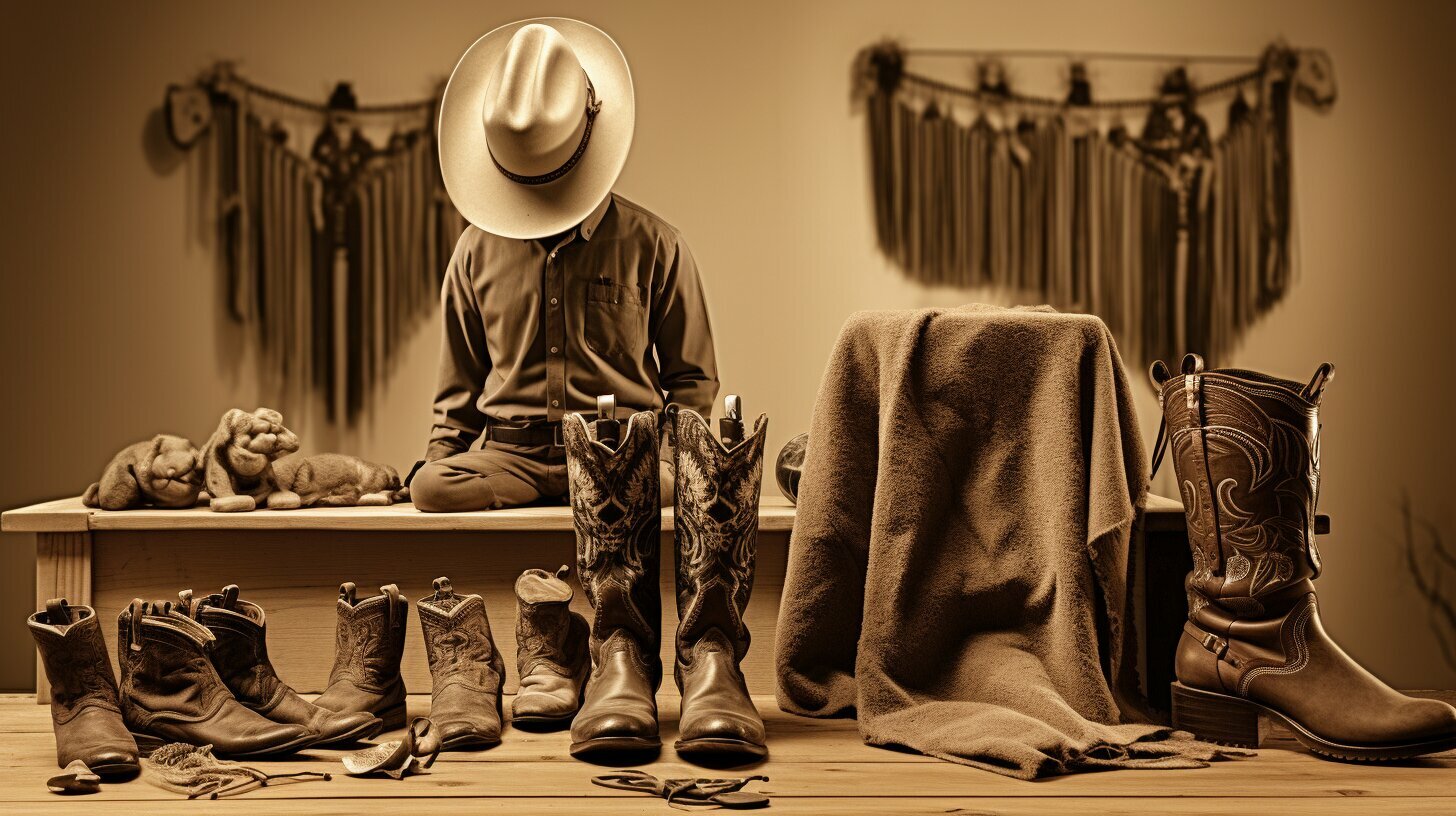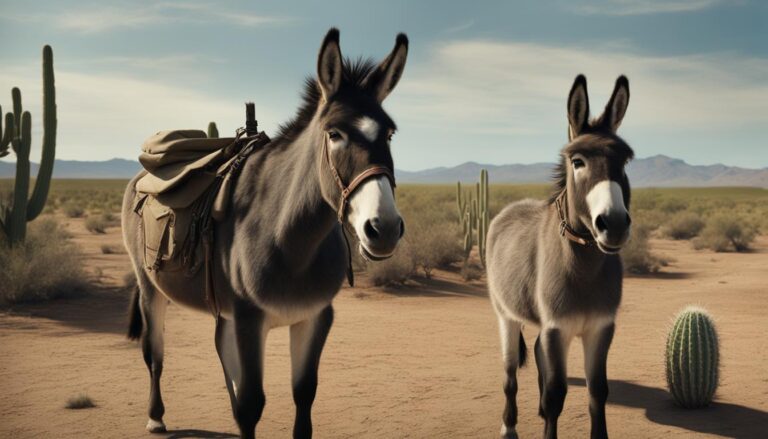Unraveling the Mystery: Why Do Cowboys Wear Spurs?
Cowboys have long been associated with the iconic accessory known as spurs, but have you ever wondered why they wear them? Spurs, those metal gadgets strapped to their boots, serve both practical and symbolic purposes in cowboy culture. Let’s dive into the importance of spurs and unravel the mystery behind their presence on every cowboy’s heel.
Key Takeaways:
- Spurs are worn by cowboys for practical reasons and as a symbol of skill and tradition.
- They are used to communicate with the horse, providing gentle cues for movement or specific maneuvers.
- Tactful and responsible use of spurs is crucial to ensure the horse’s welfare and comfort.
- Spurs have a rich history dating back to the Iron Age and are not exclusive to cowboy culture.
- Proper attachment and care of spurs are essential for their longevity and optimal performance.
A Closer Look at the History of Spurs
To understand why cowboys wear spurs, it’s important to take a trip back in time and uncover the fascinating history behind these unique accessories. Cowboys and spurs have been intrinsically linked for centuries, with the origins of spurs dating back to the Iron Age.
In the early days, spurs served a practical purpose for horseback riders, allowing them to communicate effectively with their horses. The traditional use of spurs in western riding can be traced back to the Spanish conquistadors who brought their riding techniques to the Americas.
Spurs evolved over time, with various designs and styles emerging to suit different riding disciplines. The shape and length of the spur, along with the rowels, which are the small revolving wheels at the end of the spurs, were customized to meet the specific needs of cowboys and riders. This versatility allowed them to use subtle cues and signals to guide their horses with precision and finesse.
Today, spurs continue to be an essential part of horseback riding, not just in cowboy culture, but in various equestrian disciplines. They have become a symbol of skill, tradition, and a connection to the rich history of the American West. While their practical purpose remains unchanged, it is crucial for riders to use spurs responsibly to ensure the welfare and well-being of their horses.
A Closer Look at the History of Spurs
| Time Period | Significance |
|---|---|
| Iron Age | The earliest evidence of spurs can be traced back to the Iron Age, showing their long history as tools for horseback riding. |
| Spanish Conquistadors | The Spanish conquistadors brought their riding techniques and the use of spurs to the Americas, greatly influencing cowboy culture. |
| Evolution of Design | Spurs evolved over time with various designs and styles, customized to meet the specific needs of cowboys and riders in different disciplines. |
| Symbol of Skill and Tradition | Today, spurs have become a symbol of skill, tradition, and a connection to the rich history of the American West. |
The Functional Purpose of Spurs
While spurs may seem like mere decorative additions to a cowboy’s boots, they serve a practical purpose in horseback riding. The benefits of wearing spurs are twofold: they provide advanced communication between the rider and the horse, and they aid in enhancing the rider’s control and precision.
Spurs act as an extension of the rider’s leg, enabling them to deliver subtle cues to the horse. With a gentle touch of the spur, the rider can convey specific commands for movement or prompt the horse to perform precise maneuvers. This level of communication is particularly crucial in highly skilled riding disciplines, where nuanced cues can make all the difference between success and failure.
However, it is important to note that the purpose of wearing spurs is not to inflict pain or discomfort on the horse. Responsible riders understand that tactful use of spurs is crucial. Proper training and technique ensure that the rider’s aids are clear and understood by the horse, without causing any harm. The well-being and welfare of the horse should always be the paramount concern.
By understanding the purpose of wearing spurs and employing them responsibly, riders can enhance their riding experience and build a closer connection with their horses. Spurs are not just a tool; they are a testament to the skill, tradition, and timeless bond between man and horse.
Table: Different Types of Spurs
| Spur Type | Description |
|---|---|
| Rowel Spurs | Feature a revolving wheel-like disc with pointed edges called a rowel, which can provide gentle or more assertive cues depending on the size and shape. |
| Prince of Wales Spurs | Consist of a small knob at the end, designed to deliver more precise cues with less intensity. |
| Bumper Spurs | Equipped with a rubber or plastic bumper on the end, offering less aggressive encouragement to the horse while still providing effective communication. |
In conclusion, the purpose of wearing spurs in horseback riding goes beyond aesthetics. They are a functional tool that allows riders to communicate subtle commands and enhance their control. Responsible use of spurs is essential, ensuring the well-being of the horse while maintaining the age-old tradition of the cowboy culture.
Proper Attachment and Care of Spurs
Ensuring that spurs are properly attached and well-maintained is essential for both the cowboy’s safety and the horse’s comfort. When it comes to attaching spurs, a secure fit is crucial. The spurs should be positioned on the heel of the boot, with the shank pointing downward. It’s important to check that the straps or chains are properly fastened and not too tight to restrict movement or too loose to risk slipping off during riding.
In terms of maintenance, regular cleaning and inspection are key. After each ride, it’s recommended to wipe off any dirt or debris from the spurs using a damp cloth. This helps prevent buildup and potential damage to the spurs over time. Additionally, it’s good practice to periodically check for any signs of wear or damage such as rust, loose parts, or blunt rowels.
For optimal performance and longevity of spurs, occasional oiling is recommended. Applying a small amount of light oil to the moving parts and rowels can help maintain smooth motion and prevent rust. It’s important to avoid over-oiling, as excessive oil can attract dirt and cause buildup, which may affect the functionality of the spurs.
To summarize, proper attachment and care of spurs are vital for ensuring a safe and comfortable riding experience. By securely positioning the spurs on the boots and regularly cleaning and maintaining them, cowboys can maximize the performance and longevity of their spurs, while also prioritizing the well-being of their horses.
| Proper Attachment and Care of Spurs |
|---|
| Ensure spurs are securely attached to boots |
| Position spurs on the heel with the shank pointing downward |
| Check straps or chains for proper fastening |
| Maintenance Tips |
| Wipe off dirt and debris after each ride using a damp cloth |
| Regularly inspect for wear, damage, or rust |
| Apply a small amount of light oil for smooth motion and rust prevention |
Spurs as a Symbol of Cowboy Identity
Beyond their practical function, spurs have become a powerful symbol of the cowboy way of life. These small, metal attachments worn on the boots have come to represent more than just a tool for communication with the horse. They embody the skill, tradition, and unwavering connection to the rich history of the American West that defines the cowboy identity.
When you see a cowboy strutting with spurs jingling on their boots, you can’t help but be reminded of the fearless cowboys who tamed the Wild West. Spurs have become an iconic emblem of the rugged individuals who braved the frontier, herding cattle, and conquering the untamed landscapes.
As the saying goes, “A cowboy is only as good as the horse he rides.” Spurs signify the expertise and prowess of the rider. They are a testament to the rider’s ability to communicate subtly with their mount, using the gentle nudges of the spurs to guide the horse’s movement or execute precise maneuvers. Indeed, the responsible use of spurs is a demonstration of the deep respect cowboys have for their trusted steeds.
Spurs as a symbol of cowboy identity transcend beyond the realm of the American West. The allure and mystique of the cowboy culture have inspired riders around the world, embracing the spirit of the cowboy way of life. From rodeos to equestrian competitions, spurs continue to be a cherished accessory in various riding disciplines. No matter the setting, the jingle of spurs serves as a reminder of the timeless bond between humans and horses, and the enduring legacy of the cowboy spirit.
Table: Cowboy Spurs in Different Riding Disciplines
| Riding Discipline | Spur Style |
|---|---|
| Rodeo | Rowels with long shanks for quick response and control |
| Western Pleasure | Decorative spurs with shorter, blunt rowels |
| Dressage | Discipline-specific spurs with small rowels or knob ends |
| Trail Riding | Functional yet stylish spurs with short shanks and rounded rowels |
In conclusion, spurs are not merely accessories worn by cowboys. They hold a deep meaning that goes beyond their practical function. Spurs symbolize the spirit, skill, and heritage of the cowboy way of life. Whether in the vast plains of the American West or in various riding disciplines worldwide, the sight and sound of spurs evoke a sense of adventure, raw courage, and a connection between rider and horse that transcends time.
Spurs in Riding Disciplines Beyond Cowboy Culture
While cowboys may be most commonly associated with spurs, these accessories find their place in a wide range of riding disciplines. From dressage to show jumping, and everything in between, spurs have become a valuable tool for riders seeking fine-tuned control and enhanced communication with their horses.
In dressage, where precision and harmony between horse and rider are paramount, spurs are used to give subtle cues for specific movements. The rider’s leg position and the gentle touch of the spur aid in achieving the desired level of collection and engagement. It’s an art form that requires finesse and skill, showcasing the deep connection between horse and rider.
Show jumpers, on the other hand, rely on spurs to maintain impulsion and adjust their horse’s stride when navigating complex courses. With split-second decisions and high-speed jumps, the use of spurs can provide the necessary control to execute tight turns and clear obstacles with ease.
Spurs in Western Pleasure Riding
In western pleasure riding, where riders aim for a smooth, relaxed, and collected appearance, spurs are used to guide the horse through subtle cues. The judicious use of spurs helps maintain gait transitions and precise movements, creating a harmonious flow between horse and rider. It’s a discipline that showcases the versatility of spurs beyond the traditional cowboy culture.
From the elegant movements of dressage to the adrenaline-fueled jumps of show jumping and the graceful strides of western pleasure, spurs have found their place in various riding disciplines. When used responsibly and with respect for the horse’s well-being, these accessories offer riders the finesse and control needed to excel in their chosen discipline.
| Riding Discipline | Use of Spurs |
|---|---|
| Dressage | Subtle cues for specific movements and engagement |
| Show Jumping | Maintaining impulsion and adjusting stride |
| Western Pleasure | Guiding the horse through smooth gait transitions and movements |
Responsible Use of Spurs: Ensuring Horse Welfare
Cowboys understand the value of treating their horses with respect, and using spurs responsibly is an essential aspect of responsible horsemanship. When it comes to wearing spurs, it’s crucial to prioritize the well-being and comfort of the horse. Tactful and considerate usage is key to maintaining a harmonious partnership between rider and steed.
First and foremost, it’s important to remember that spurs are not meant to inflict pain or discomfort on the horse. Instead, they are tools for communication and subtle cues. Cowboys employ spurs to convey their intentions to the horse, guiding them through movements and maneuvers with precision and finesse. By using spurs responsibly, cowboys can enhance their connection with the horse and facilitate a smooth riding experience.
Responsible use of spurs also means understanding the individual needs and sensitivities of the horse. Each horse is unique, and what may work for one might not be suitable for another. Cowboys must take the time to develop a bond with their horse and learn how to adapt their riding style to accommodate the specific needs and preferences of their equine partner.
Proper Attachment and Care of Spurs
In addition to responsible usage, the proper attachment and care of spurs are vital for maintaining their longevity and performance. When attaching spurs to boots, it’s important to ensure a secure fit that prevents slippage during riding. This can be achieved by using spurs that are the correct size and shape for the rider’s boots.
Caring for spurs involves regular cleaning and inspection. Dirty or rusty spurs can cause discomfort and even injury to the horse’s skin. By cleaning spurs after each ride and applying a light coat of oil to prevent rusting, cowboys can ensure the well-being of their horse and extend the lifespan of their spurs.
| Key Points: |
|---|
| – Spurs are used to communicate with the horse and provide gentle cues for movement. |
| – Tactful and responsible use of spurs is crucial to avoid causing harm or discomfort to the horse. |
| – Proper attachment and care of spurs are essential for longevity and optimal performance. |
| – Cowboys should prioritize the well-being and comfort of their horses when using spurs. |
In conclusion, responsible use of spurs is an integral part of being a responsible cowboy. By understanding the value of treating their horses with respect and using spurs as a means of communication rather than punishment, cowboys can foster a strong bond with their equine companions. By prioritizing the well-being of their horses and taking proper care of their spurs, cowboys can ensure a safe and enjoyable riding experience for both horse and rider.
In Conclusion
By unraveling the mystery behind the use of spurs, we gain a deeper appreciation for their role in cowboy culture and the art of horsemanship. Cowboys wear spurs on their boots not only for practical reasons but also as a symbol of their skill and tradition. These seemingly simple accessories have a rich history dating back to the Iron Age, making them a significant part of the cowboy identity.
Spurs serve a functional purpose, allowing cowboys to communicate with their horses. Through gentle cues, riders can guide their equine partners, facilitating movement and specific maneuvers. However, it is important to highlight the responsible and tactful use of spurs to ensure the well-being and comfort of the horse.
Not restricted to cowboy culture alone, spurs are a common accessory in various riding disciplines. Equestrians across the world appreciate the benefits of properly attaching and caring for spurs, as they enhance longevity and performance. Whether you are a cowboy or an avid rider in a different discipline, understanding the history, function, and responsible use of spurs is essential.
In conclusion, spurs are more than just decorative trinkets on a cowboy’s boot. They embody a connection to the past, a language between rider and horse, and a symbol of the skills and traditions that define the cowboy way of life. So, the next time you see a cowboy wearing spurs, remember the storied history and the careful balance it takes to master the art of horsemanship.
FAQ
Why do cowboys wear spurs?
Cowboys wear spurs for practical reasons and as a symbol of skill and tradition. Spurs are used to communicate with the horse, providing gentle cues for movement or specific maneuvers.
What is the history of cowboy spurs?
Spurs have a rich history dating back to the Iron Age. They became an integral part of cowboy culture and have been traditionally used in western riding. They hold significance in horseback riding as a whole.
What is the functional purpose of spurs?
Spurs allow cowboys to communicate with their horses effectively. They provide gentle cues for movement and specific maneuvers. It’s important to use spurs responsibly and tactfully, ensuring they don’t cause harm or discomfort to the horse.
How should spurs be attached and cared for properly?
Proper attachment and care of spurs are crucial for their longevity and performance. It’s important to securely attach them to boots and maintain them regularly to ensure optimal performance.
What do spurs symbolize in cowboy culture?
Spurs have become a symbol of cowboy identity. They represent skill, tradition, and a connection to the rich history of the American West. They are an iconic part of the cowboy image.
Are spurs exclusive to cowboy culture?
No, spurs are commonly used in various equestrian disciplines beyond cowboy culture. They have universal application in horseback riding and are not limited to cowboys alone.
How can spurs be used responsibly to ensure horse welfare?
Responsible use of spurs is essential to ensure the welfare and well-being of the horse. Cowboys and riders should adhere to guidelines and ethical considerations when using spurs to prevent any harm or discomfort to the horse.






